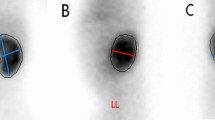Abstract
The sonograms of 115 infants with normal renal function ranging in age from 1 to 120 days used to determine renal parenchymal echogenicity by densitometry. The measured values were contrasted with the evaluations of 4 independent examiners who rated renal echogenicity as “less than”, “equal to” or “greater than” that of the liver. The results revealed that naked eye evaluation does not permit a clear distincition between the categories of echogenicity and also that the assessments of the individual examiners differed considerably. Contrary to the previously held view the present findings indicate that the initially increased renal parenchymal echogenicity in neonates has developed into the normal hypoechoic condition after 1 month. One should take these findings into account when evaluating renal sonograms of infants, especially if no densitometric data are available.
Similar content being viewed by others
References
Winkler P, Altrogge H (1985) Sonographic signs of nephritis in children. Pediatr Radiol 15: 213
Rosenfield AT, Siegel NJ (1980) Renal parenchymal disease: Histopathologic-sonographic-correlation. AJR 137: 793
Vergesslich KA, Mileder P, Ponhold W (1988) Die Änderung der renalen Echogenität bei kindlichen obstruktiven Uropathien. Ultraschall 9: 163
Cramer BC, Jequier S, de Chadarevian IP (1986) Factors associated with renal parenchymal echogenicity in newborn. J Ultrasound Med 5: 633
Ponhold W, Vergesslich KA (1986) Das Verhalten der renalen parenchymatösen Echogenität bei kindlichen nephro-urologischen Erkrankungen. Nieren Hochdruck 15: 540
Boal F, Teele RL (1980) Sonography of infantile polycystic kidney disease. AJR 135: 575
Erwin BC, Carroll BA, Muller H (1985) A sonographic assessment of neonatal renal parameters. J Ultrasound Med 4: 217
Hricak H, Cruz C, Romanski R, Uniewski MH, Levin NW, Madrazo B, Sandler MA, Egler W (1982) Renal parenchymal disease: sonographic histologic correlation. Radiology 144: 141
Han BK, Babcock DS (1985) Sonographic measurements and appearance of normal kidneys in children. AJR 145: 611
Lamont AC, Graebe AC, Pelmore JM, Thompson JR (1989) Ultrasound assessment of renal cortical brightness in infants, is naked eye evaluation reliable? 26th Congress of the European Soc Paediatr Radiol: P 12
Platt JF, Rabin JM, Bowerman RA, Marn CS (1987) The inability to detect kidney disease on the basis of echogenicity. AJR 151: 317
Haller JO, Berdon WE, Friedman AP (1982) Increased renal cortical echogenicity: a normal finding in neonates and infants. Radiology 142: 173
Author information
Authors and Affiliations
Rights and permissions
About this article
Cite this article
Eggert, P., Debus, F., Kreller-Laugwitz, G. et al. Densitometric measurement of renal echogenicity in infants and naked eye evaluation: A comparison. Pediatr Radiol 21, 111–113 (1991). https://doi.org/10.1007/BF02015619
Received:
Accepted:
Issue Date:
DOI: https://doi.org/10.1007/BF02015619




